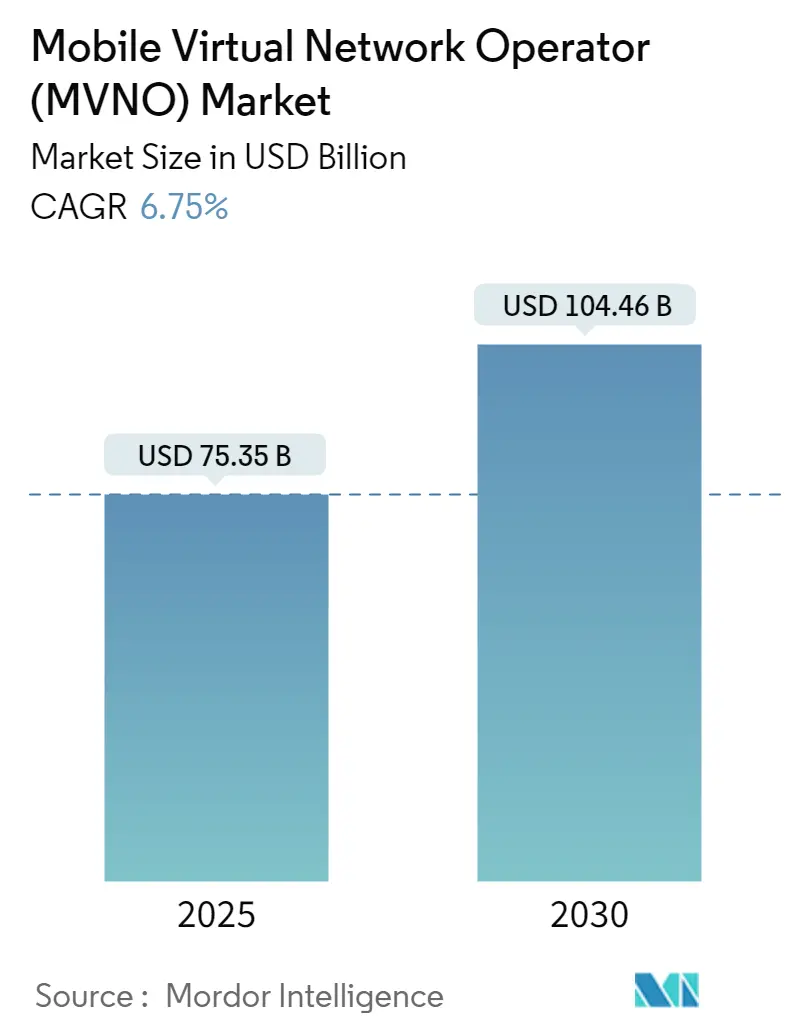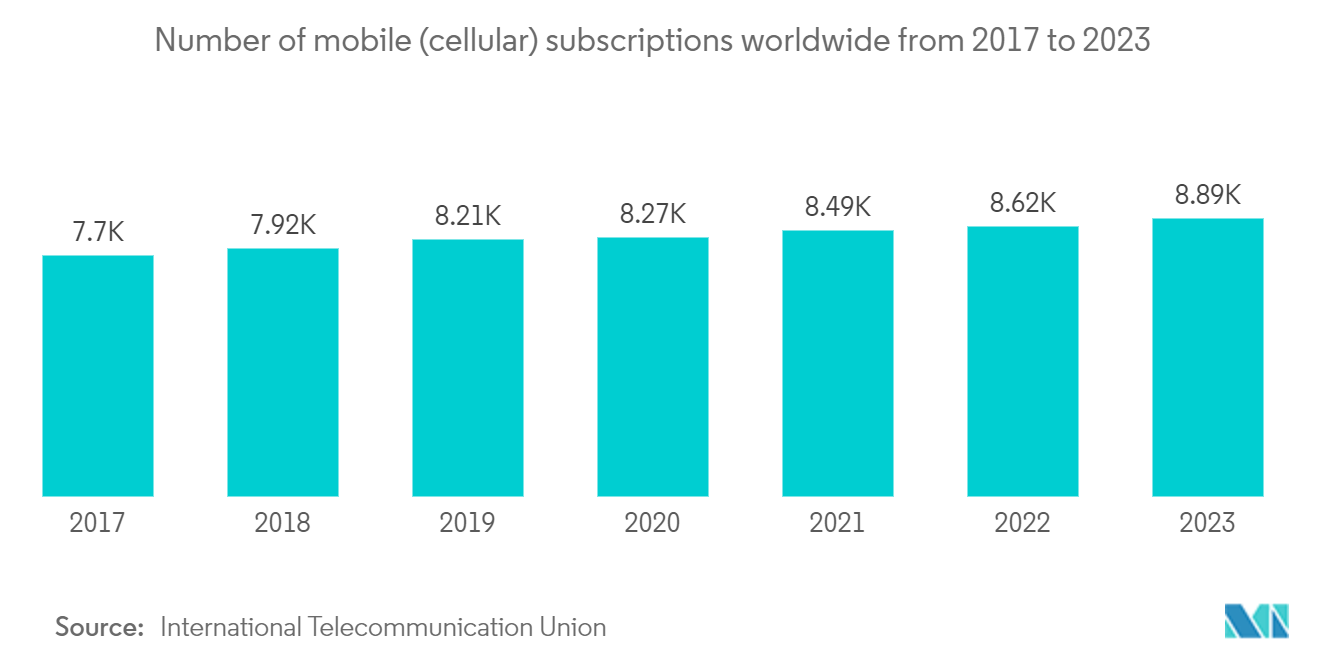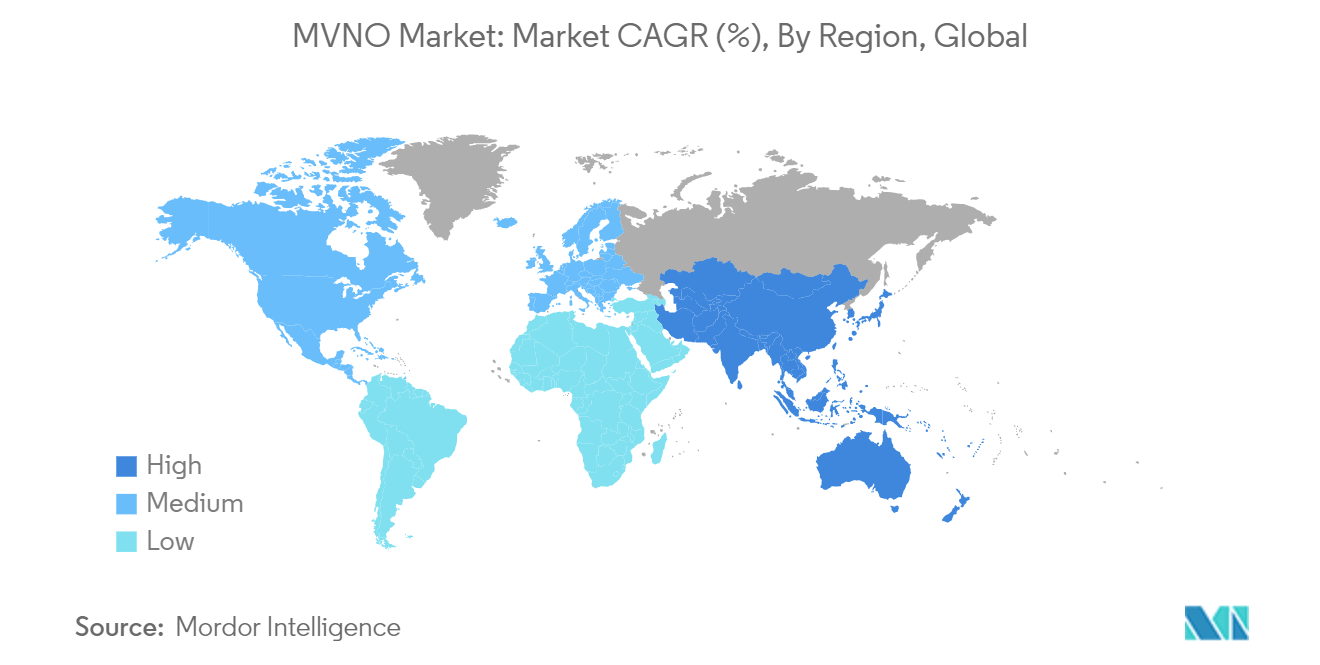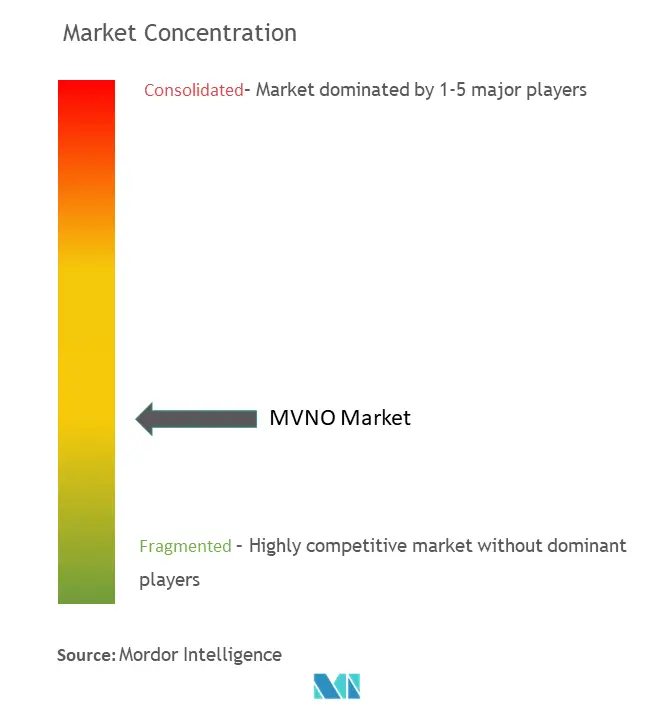Mobile Virtual Network Operator (MVNO) Market Analysis
The Mobile Virtual Network Operator Market size is estimated at USD 75.35 billion in 2025, and is expected to reach USD 104.46 billion by 2030, at a CAGR of 6.75% during the forecast period (2025-2030).
- The MVNO market is experiencing robust growth due to the increasing demand for affordable and flexible mobile services, which MVNOs are well-positioned to provide. They attract a broad customer base by offering competitive pricing, tailored plans, and innovative service packages, meeting the diverse needs of cost-conscious consumers.
- Technological advancements, particularly the expansion of 4G and 5G networks, are also crucial. These advancements enable MVNOs to offer high-quality, data-intensive services that appeal to tech-savvy users. The integration of eSIM technology and IoT solutions further enhances their service offerings, catering to the growing market for connected devices and smart applications.
- Regulatory support in various regions encourages the proliferation of MVNOs, fostering competition and improving overall service quality. This regulatory environment helps MVNOs to negotiate favorable terms with MNOs, ensuring access to essential network resources. Moreover, strategic partnerships between MVNOs and MNOs facilitate innovation and operational efficiency, allowing MVNOs to focus on customer experience and unique value propositions. The trend toward digital transformation across industries drives businesses to seek scalable, flexible mobile solutions, boosting MVNO adoption.
- The MVNO market is expanding, driven by the increasing adoption of connected devices and high-speed data applications. In February 2024, MyRepublic, in collaboration with Singtel and StarHub, introduced 10 Gbps plans, such as HyperSpeed 10 Gbps and GAMER 10 Gbps, catering to the growing demand for enhanced in-home connectivity, particularly among gamers who seek lower latency. This move underscores the rising interest in MVNO data services projected for the coming years.
- Retail MVNO subscriptions can offer users benefits like grocery discounts and enhanced loyalty card perks. Moreover, they empower retailers to precisely target their customer segments. Asda Mobile, a service by Asda Supermarket, exemplifies a retail MVNO. Also, services like cloud computing, machine-to-machine (M2M) transactions, and mobile money are on the rise, driving the overall demand for mobile virtual network operators in the coming years.
- However, the growth of the MVNO market is restricted by challenges such as intense competition from established MNOs, regulatory hurdles, limited access to network infrastructure, and lower profit margins. Additionally, consumer awareness and trust issues, along with the high cost of acquiring new customers, further constrain market expansion.
Mobile Virtual Network Operator (MVNO) Market Trends
The Consumer Segment is Expected to Hold a Significant Market Share
- The MVNO market's expansion is primarily fueled by the increasing number of subscribers. With a rising mobile user base, the overall demand for cost-effective and adaptable mobile services is expected to grow. MVNOs seize this opportunity by providing competitive rates and inventive service bundles, positioning themselves as compelling substitutes to conventional MNOs.
- Additionally, the surge in mobile internet usage and the surge in the adoption of smartphones are driving the demand for data-intensive services. Mobile virtual network operators (MVNOs) are primed to meet this need. Their agility in rolling out specialized services positions them to leverage the latest trends and tech developments, notably 5G and IoT. The growing subscriber base also encourages regulatory bodies to support MVNOs and recognize their role in promoting competition and improving service quality. This regulatory backing further boosts the market's attractiveness.
- Driven by consumer demand for customization and affordability, MVNOs are building specialized plans, including pay-as-you-go, family bundles, and data-centric packages. By catering to a broad array of preferences, these MVNOs bolster customer satisfaction, fostering loyalty and fueling market expansion. Moreover, as more consumers switch to MVNOs, the increased market competition compels all players to innovate continuously, enhancing the overall quality and variety of mobile services available, thereby driving further growth in the MVNO market.
- The prominent players in the market provide wireless services at competitive costs worldwide. For instance, in July 2024, Boost Mobile, the latest entrant in the national wireless carrier landscape, introduced its advanced 5G Boost Mobile network in the industry. Its easy-to-understand properties cater to a wide spectrum of consumers, emphasizing flexibility. Furthermore, Boost Mobile is revamping its brand, introducing an upgraded digital buying experience, and bringing innovation into the traditionally stagnant wireless industry.
- Traditionally, the consumer segment has outshone the B2B industry in terms of innovation and pricing. Managing a fleet of devices and their billing is more complex than handling individual consumer services. Given the ease and higher profit margins, MVNOs tend to lean toward investments in the consumer sector.
Asia-Pacific is Expected to Hold a Major Market Share
- Asia-Pacific holds an extensive market share, consistently leading in the adoption of advanced technologies such as 5G, connected mobile devices, and widespread smartphone usage. The region stands out as a key market for smartphones, driven by its rapidly expanding telecom industry and large customer base. Notably, the region is also witnessing a surge in spending on wireless network services.
- Investments in the telecom industries of India, Japan, Australia, Singapore, and South Korea are on the rise, fueling the demand for MVNO services in the region. Regulatory backing in these countries has proven pivotal. Governments are actively endorsing MVNOs to bolster competition and elevate service standards, fostering a market that is both dynamic and consumer-centric. The swift proliferation of 4G and 5G networks equips MVNOs with the necessary infrastructure to provide services compared to conventional MNOs.
- Partnerships between mobile virtual network operators (MVNOs) and mobile network operators (MNOs) play a crucial role. These partnerships provide MVNOs with network resources that enable them to concentrate on customer service and distinctive value offerings. Moreover, technological advancements, like eSIMs and IoT integrations, bolster MVNOs' attractiveness, especially to tech-savvy consumers and businesses with a focus on tailored connectivity solutions. Additionally, the growing trend of digital transformation and the need for flexible, scalable mobile solutions among enterprises are driving MVNO adoption in Asia-Pacific.
- In July 2024, Digital Wallet Solutions Corporation (DWS), a subsidiary of Digital Wallet Corporation (DWC), a rapidly expanding Japanese fintech giant, unveiled its latest MVNO service, "Smiles Connect," in Japan. Users can now conveniently purchase SIM plans through Japan's "Absolute No.1 Smiles Mobile Remittance" app, a creation of DWC.
- Developing countries like India and Indonesia are witnessing a surge in smartphone adoption, particularly in rural areas, propelled by governmental initiatives to bolster digital and mobile economies. This trend is expected to fuel the demand for entry-level smartphones. The country's Digital India initiative spearheads the nation's vision of becoming digitally empowered.
Mobile Virtual Network Operator (MVNO) Industry Overview
The MVNO market is highly competitive in nature, primarily due to the presence of various players. Major players in the market are increasingly turning to strategies such as service innovation and forming strategic partnerships. These companies aim to broaden their client base and bolster their competitiveness in the industry. Industry players such as Lebara Group BV, TracFone Wireless Inc., and FRiENDi Mobile dominate the market.
- July 2024: Mediacom Communications unveiled Mediacom Mobile, a new venture that the company will operate in partnership with Verizon Communications, its multichannel video network operator (MVNO) partner. Mediacom Mobile, the new service, is exclusively available to customers who subscribe to the operator's home broadband or pay-TV service.
- June 2024: TDS Telecommunications LLC (TDS Telecom), headquartered in Madison, Wisconsin, finalized an agreement with Reach, a Software-as-a-Service platform for launching network-based services with speed and simplicity. TDS Mobile is set to leverage a national 5G network, marking its foray into the MVNO market, facilitated by its partnerships with the National Content & Technology Cooperative (NCTC).
Mobile Virtual Network Operator (MVNO) Market Leaders
-
Lebara Group BV
-
TracFone Wireless Inc.
-
FRiENDi Mobile
-
Boost Mobile LLC
-
Virgin Mobile USA Inc.
- *Disclaimer: Major Players sorted in no particular order
Mobile Virtual Network Operator (MVNO) Market News
- July 2024: T-Mobile introduced "Your Name, Our Wireless," a solution that simplifies the process for both traditional and non-traditional MVNOs to establish and manage their personalized wireless services. This service operates on the United States' most extensive and highly acclaimed 5G network. Your Name, Our Wireless offers an end-to-end managed and operated solution. It streamlines backend setup and daily operations, empowering companies to prioritize customer engagement and pursue new revenue streams.
- December 2023: NextGen Co. Ltd teamed with MATRIXX Software, a player in 5G and digital monetization solutions based in California, to introduce a consolidated billing platform. NextGen leveraged its implementation expertise and technical acumen to build a solution that holistically caters to mobile virtual network operator's (MVNO's) business needs, encompassing both operational support and consulting services.
Mobile Virtual Network Operator (MVNO) Industry Segmentation
Mobile virtual network operators (MVNOs) are wireless service providers that, rather than owning wireless network infrastructure, purchase network capacity from established MNOs to provide services to their customers.
The mobile virtual network operator (MVNO) market is segmented by deployment (cloud and on-premise), operational modes (reseller, service operator, full MVNO, and other operational modes), subscriber (enterprise and consumer), applications (discount, cellular M2M, business, media and entertainment, migrant, retail, roaming, and telecom), and geography (North America [United States and Canada], Europe [Germany, United Kingdom, France, Italy, Spain, and Rest of Europe], Asia-Pacific [China, India, Japan, South Korea, and Rest of Asia-Pacific], Latin America [Brazil, Argentina, Colombia, Mexico, and Rest of Latin America], and Middle East and Africa [United Arab Emirates, Saudi Arabia, South Africa, and Rest of Middle East and Africa]).
The market sizes and forecasts are provided in terms of value (USD) for all the above segments.
| Deployment | Cloud | ||
| On-premise | |||
| Operational Mode | Reseller | ||
| Service Operator | |||
| Full MVNO | |||
| Other Operational Modes | |||
| Subscriber | Enterprise | ||
| Consumer | |||
| Application | Discount | ||
| Cellular M2M | |||
| Business | |||
| Media and Entertainment | |||
| Migrant | |||
| Retail | |||
| Roaming | |||
| Telecom | |||
| Geography | North America | United States | |
| Canada | |||
| Europe | Germany | ||
| United Kingdom | |||
| France | |||
| Italy | |||
| Spain | |||
| Rest of Europe | |||
| Asia-Pacific | China | ||
| India | |||
| Japan | |||
| South Korea | |||
| Rest of Asia-Pacific | |||
| Latin America | Brazil | ||
| Argentina | |||
| Colombia | |||
| Mexico | |||
| Rest of Latin America | |||
| Middle East and Africa | United Arab Emirates | ||
| Saudi Arabia | |||
| South Africa | |||
| Rest of Middle East and Africa | |||
Mobile Virtual Network Operator (MVNO) Market Research FAQs
How big is the Mobile Virtual Network Operator Market?
The Mobile Virtual Network Operator Market size is expected to reach USD 75.35 billion in 2025 and grow at a CAGR of 6.75% to reach USD 104.46 billion by 2030.
What is the current Mobile Virtual Network Operator Market size?
In 2025, the Mobile Virtual Network Operator Market size is expected to reach USD 75.35 billion.
Who are the key players in Mobile Virtual Network Operator Market?
Lebara Group BV, TracFone Wireless Inc., FRiENDi Mobile, Boost Mobile LLC and Virgin Mobile USA Inc. are the major companies operating in the Mobile Virtual Network Operator Market.
Which is the fastest growing region in Mobile Virtual Network Operator Market?
Asia Pacific is estimated to grow at the highest CAGR over the forecast period (2025-2030).
Which region has the biggest share in Mobile Virtual Network Operator Market?
In 2025, the Asia Pacific accounts for the largest market share in Mobile Virtual Network Operator Market.
What years does this Mobile Virtual Network Operator Market cover, and what was the market size in 2024?
In 2024, the Mobile Virtual Network Operator Market size was estimated at USD 70.26 billion. The report covers the Mobile Virtual Network Operator Market historical market size for years: 2019, 2020, 2021, 2022, 2023 and 2024. The report also forecasts the Mobile Virtual Network Operator Market size for years: 2025, 2026, 2027, 2028, 2029 and 2030.
Our Best Selling Reports
MVNO Industry Report
The MVNO market is experiencing significant growth, driven by the increasing adoption of IoT, M2M, and BYOD technologies. This growth is further supported by strategic infrastructure sharing between MVNOs and MNOs, enabling cost-effective service delivery and enhanced profit opportunities. Despite facing regulatory constraints and prioritization issues during network congestion, the market is poised for expansion, particularly in the enterprise segment which benefits from the scalable and cost-efficient nature of MVNO services.
Geographically, Europe remains a dominant player due to high demand for affordable data services and the support of major telecom entities. The MVNO market trends suggest a dynamic sector with a focus on tailored services and customer segmentation, expected to propel the mobile virtual network operator market size in the upcoming years.
The market share and market size are crucial indicators of the industry’s health, with market analysis and market research providing deeper insights into market trends. Global market dynamics and the growth rate are essential for understanding the industry outlook. Industry reports and industry research offer valuable industry statistics and market forecast, contributing to a comprehensive market overview.
Market growth is driven by market leaders who set the pace for the industry. The market outlook and market predictions help in anticipating future trends, while market review and market segmentation highlight the diverse applications and user bases within the market. The market value is a testament to the industry's significance, and the availability of a report PDF ensures that detailed industry information is accessible.
In conclusion, the MVNO market is characterized by robust growth and evolving industry trends. Market data and industry analysis are pivotal for stakeholders to navigate this dynamic landscape, ensuring they stay ahead of market predictions and capitalize on emerging opportunities.

-Market-ML.webp)





